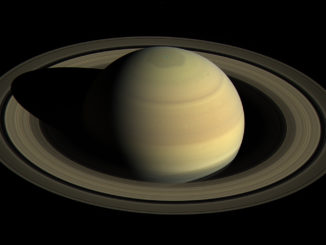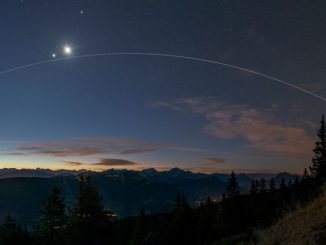
Saturn is easily identified since it currently lies some 11° (or the span of a fist at arm’s length) to the upper right of first magnitude zodiacal star Antares in Scorpius for northern observers. But if you wish for an unequivocal celestial guide, then the the rising 14-day-old waxing gibbous Moon is just 1.7° to the left of Saturn in the south-southeast at 11 pm BST on June 1st as seen from the centre of the British Isles. This is close enough for the pair to be seen in the same field of view of telescopes and binoculars magnifying 25x or less.
As you contemplate this conjunction of the Moon and Saturn late into the night of June 1st, reflect on the fact that this is merely a line of sight effect; the Moon will be about 239,800 miles (386,000 kilometres) away, but Saturn will lie 835 million miles (1,344 million kilometres) from us — a staggering nine times the distance between the Earth and Sun!
June 2nd’s Full Moon rising in the southeast forms an right-angled triangle with Antares and Saturn, but the Moon’s angular separation from the ringed planet will have increased to almost 15°. Clear skies!
Inside the magazine
You can find out more about observing Saturn in the June edition of Astronomy Now in addition to a full observing guide to the night sky.
Never miss an issue by subscribing to the UK’s biggest astronomy magazine. Also available for iPad/iPhone and Android devices.




